Part 2: After a boisterous delivery from Pensacola to Key West, the author and two pals set off in his Catalina 31 with an organized rally to Cuba (published January/February 2018)
A blast from the air horn at 3 pm announced the start of the rally to Cuba, 97 miles across the Straits of Florida. The event was organized by a Key West yacht charter company and sponsored by Fountaine Pajot among others. Yachts ranging in size from our small 31-foot Catalina, Sea Horse, to 60-foot catamarans jockeyed for position in the narrow channel leading to the Atlantic Ocean. After weeks of preparation, Havana was now within reach! 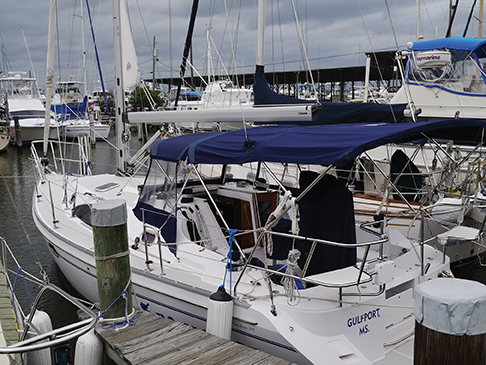
I felt confident in the crew, both Vadim and Alex had been somewhat battle tested in the previous stages of our journey. (See part one in the November-December issue) Vadim, although born in Moscow, spent 11 years in Siberia as a construction engineer for a railroad and tunnel building company in the former Soviet Union. He is an avid outdoorsman with a stoic personality. Past adventures included running the New York Marathon, helicopter skiing and in his youth, competitive swimming at the Junior Olympic level.
Alex, also from Moscow, has an artistic background and holds an upper management position in a graphic arts firm. His brother-in-law, Mikhail Lavrovsky, a former principal dancer of the Bolshoi Ballet, is a world renowned choreographer in the performing arts. Alex is soft spoken but becomes animated with a wide grin at the prospect of adventure. He has ridden his motorcycle throughout the U.S. and Mexico and he jumped at the chance to experience blue water sailing.
DARK ‘N STORMY NIGHT
The ride for the next twenty five miles was bumpy but the three of us made good headway sailing at six to seven knots as the fleet began to spread out. Eventually, a beautiful sunset marked the end of daylight and the beginning of a challenging night.
Approaching the Gulf Stream with its easterly flowing current, conditions worsened considerably. A strong wind from the east collided with the east-flowing current producing substantial swells. Later that night, most boats reported 8-to-10-foot wave heights with an occasional 12 footer and one reported a 15 footer. The wind indicator began rising from 16 to 20 knots as midnight approached. Around 3 am, the wind reached 25 knots; the confused seas were pounding us from different directions under the influence of wave and current. It was difficult to be heard.
I approached Alex to take my turn at the helm.
“Let me continue on,” he shouted. “I’m afraid we will lose control of the wheel in the transition!”
I went below and was promptly thrown from port to starboard by the force of a rogue wave. Sea Horse surfed as the bow lifted out of the water before slamming downward. I checked the previously broken ribs and everything seemed to be intact but I retreated topside to escape the cabin.
Alex reluctantly gave up the helm and I settled in for my two hour watch. It wasn’t long before another rogue wave crashed over the cockpit drenching me with a salt water shower. The genoa and main were reefed hours earlier but I decided to reduce sail to a bare minimum, just enough to provide enough steerage to keep Sea Horse on course and prevent the mast from rocking side to side.
While pulling in on the reefing line, it became entangled with the working genoa sheet, transforming both into a giant egg beater that shredded the sun strip on the genoa and ripped into the isinglass window of the dodger. Finally, after several minutes, we managed to wrestle the lines from the force of the wind and cleat them off. Our anxiety level was high but we were not alone; running lights in the distance from six other boats followed us in lockstep as we struggled through the night.
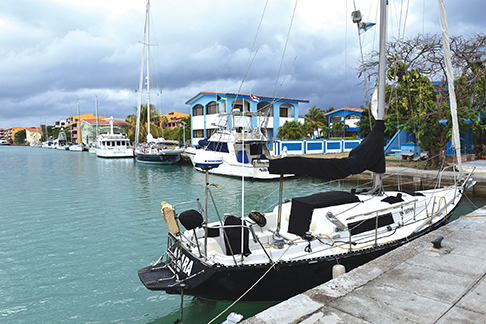 Mercifully, dawn arrived with diminished winds and seas. In the distance, I could see the dim outline of Havana but many hours remained before we would arrive at Hemingway Marina, our port of entry. Later, at the Customs dock, a cadre of officials, a doctor, nurse, and two drug-sniffing dogs descended upon Sea Horse. After satisfying their entry requirements and fending off requests for “regalos”, we pulled down the yellow quarantine flag and hoisted the Cuban courtesy flag. This resulted in heated shouts of indignation, “La bandera Cubana está colgada al revés!” We had provoked an international incident by raising the Cuban flag upside down! Vadim and Alex quickly corrected our mistake and a pilot boat led the way to our assigned slip. After a 2- hour crossing and some embarrassment, our visit to Cuba had begun.
Mercifully, dawn arrived with diminished winds and seas. In the distance, I could see the dim outline of Havana but many hours remained before we would arrive at Hemingway Marina, our port of entry. Later, at the Customs dock, a cadre of officials, a doctor, nurse, and two drug-sniffing dogs descended upon Sea Horse. After satisfying their entry requirements and fending off requests for “regalos”, we pulled down the yellow quarantine flag and hoisted the Cuban courtesy flag. This resulted in heated shouts of indignation, “La bandera Cubana está colgada al revés!” We had provoked an international incident by raising the Cuban flag upside down! Vadim and Alex quickly corrected our mistake and a pilot boat led the way to our assigned slip. After a 2- hour crossing and some embarrassment, our visit to Cuba had begun.
EXPLORING CUBA
The next stop was a welcoming party hosted by Commodore José Escrich of the Hemingway Yacht Club. This gave us the opportunity to mingle with crews from other yachts in the rally. It seemed our experience on the sail down was not unique. One attractive lady wearing blue shorts was covered in bruises to her thigh and legs. She told me she was tossed about the cabin just as I had been earlier.
There were reports that one or two boats turned back to attempt the crossing the next day. There was at least one other report of a sail being shredded and multiple accounts of seasickness. I struck up a conversation with the captain of one yacht who held a Coast Guard Operator’s License. I asked him if any of his crew threw up. He replied, “Yeah, me.” The evening concluded with some remarks by Commodore Escrich, announcing that Club Nautico International Hemingway de Cuba now had over 3,000 members including 1,000 Americans.
“¿Quieres chicas?” We were approached several times as we became familiar with the layout of the Marina. It came as no surprise that in Cuba, sex is readily available for a price. We politely declined the invitations. Hemingway Marina is situated nine miles to the west of Havana. It covers a sizable area and includes a small hotel, swimming pool, boat slips, fuel depot, small grocery store, night club, several restaurants and the yacht club.
The facilities appear to be well maintained and service is good, however, as in most of Cuba it is impossible to find toilet paper or toilet seats for that matter. In addition, there is no sewage pump out for boat holding tanks. Obviously, advance sanitation planning is a good idea for foreign visitors. There are some positive aspects of the marina; the salon leading to the toilet and shower room contains a full bar, TV and internet connections. Hemingway Marina is very secure as Cuba is serious about protecting its tourism industry.
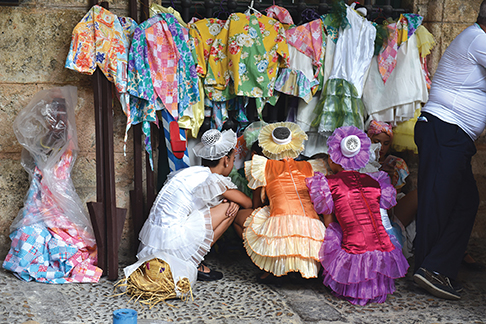 The second day our crew set out for Old Havana and new experiences. Old Havana, founded in 1519, is the original city center and was built in the baroque and neoclassical style. A pleasant morning transpired touring several spacious plazas and drinking Crystal beer available for about one CUC. Cuba has two currencies, the peso for everyday use by the Cuban people and the Cuban Convertible Peso or CUC available for foreign currency exchange. The ratio of CUC to the U.S. dollar is one to one however there is usually an additional 10 to 13 percent surcharge.
The second day our crew set out for Old Havana and new experiences. Old Havana, founded in 1519, is the original city center and was built in the baroque and neoclassical style. A pleasant morning transpired touring several spacious plazas and drinking Crystal beer available for about one CUC. Cuba has two currencies, the peso for everyday use by the Cuban people and the Cuban Convertible Peso or CUC available for foreign currency exchange. The ratio of CUC to the U.S. dollar is one to one however there is usually an additional 10 to 13 percent surcharge.
That afternoon the discovery of La Moneda, a paladar located on the roof of a building open to the ocean and a fresh breeze, brought more good times. We enjoyed seafood, more Crystal beer and excellent Cuban music by Trio Los Astros, two talented male guitarists accompanied by an attractive female singer with an infectious smile. It is common to find music throughout Old Havana but not necessarily of this quality.
I was surprised to find no photos of Fidel or Raúl Castro, however, photos of Che Guevara were plentiful. Ancient Fords, Chevrolets and Buicks from the Fifties lined the streets and Russian Ladas of more recent vintage were also present. There were no McDonalds or KFC type fast food joints, which was fine with me. After a full day, it was back to the yacht club for a night cap then on to our boat for some rest.
The next day the rally held The Parade Of Boats, in which we sailed into Havana Harbor and was to be the centerpiece of the “people to people” requirement of our travel permits. Special government permission had been granted to enter this area which is normally closed to recreational boating, plus the event would be covered by the Cuban national press.
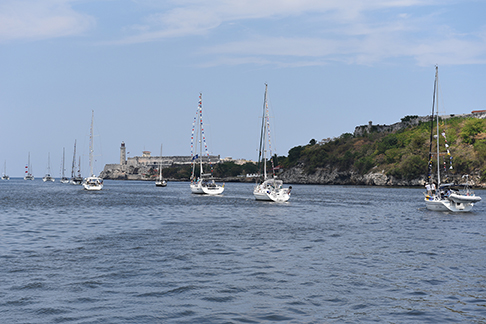 The morning brought some confusion as 60 yachts tried to assemble in formation outside the marina. But once underway our fleet sailed nine miles eastward and entered the harbor. As we sailed the last few miles, we cruised alongside the Malecón, a broad esplanade, roadway and sea wall on the northern shore of the city. From a distance, we could hear a lone man with a trumpet playing the Star Spangled Banner; it was a powerful moment. On the way out, our parade passed the Castillo del Morro, a fort built in the fifteen hundreds by the Spanish. We returned to our slip late afternoon.
The morning brought some confusion as 60 yachts tried to assemble in formation outside the marina. But once underway our fleet sailed nine miles eastward and entered the harbor. As we sailed the last few miles, we cruised alongside the Malecón, a broad esplanade, roadway and sea wall on the northern shore of the city. From a distance, we could hear a lone man with a trumpet playing the Star Spangled Banner; it was a powerful moment. On the way out, our parade passed the Castillo del Morro, a fort built in the fifteen hundreds by the Spanish. We returned to our slip late afternoon.
As the week progressed, we made a return trip to Old Havana and Plaza Vieja. Lunch was served in a small courtyard off the plaza while we chatted with some German tourists at a nearby table. Our waitress was extremely flirtatious when she heard we came on a yacht. “Take me with you” she implored.
We moved on to the plaza where the afternoon passed smoking cigars and listening to a short man with a big guitar entertain us with La Bamba and other Latin tunes. After each song he would remove the straw fedora from his head to accept tips. Impoverished street vendors approached from time to time offering a tiny bag of peanuts for a peso or two.
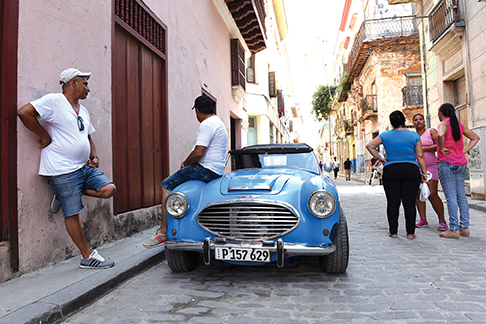 By mid-week, I started hearing rumors of a bad weather forecast to arrive close to our departure date. I questioned the organizer of the rally to see if he had any news. He informed me a “tiny” cold front was expected. Given the unpredicted weather on the way down, I was concerned. I conversed with other captains and it was clear that a major weather system was imminent. As we had planned a side trip to Las Terrezas for the next day, Wednesday, I resolved to leave Wednesday night as I had no wish for an encore of the passage down.
By mid-week, I started hearing rumors of a bad weather forecast to arrive close to our departure date. I questioned the organizer of the rally to see if he had any news. He informed me a “tiny” cold front was expected. Given the unpredicted weather on the way down, I was concerned. I conversed with other captains and it was clear that a major weather system was imminent. As we had planned a side trip to Las Terrezas for the next day, Wednesday, I resolved to leave Wednesday night as I had no wish for an encore of the passage down.
In the morning, we boarded a tour bus for Las Terrazas located 60 miles to the west. A designated Unesco Biosphere Reserve, this area is the site of the earliest coffee plantations in Cuba and in 1968 a reforestation project gave birth to a lush tropical forest populated intermittently with Royal Palms. Las Terrazas also features a botanical garden with over 700 species of orchids.
Our guide, Claudia, was an engaging lady of about 40 who dreamed of opening a small paladar if conditions in Cuba continued to improve. Like many Cubans, she had relatives in the States and was well aware of the economic disparity she lived under. The tour was certainly worthwhile but I was anxious to return and depart for Key West. At 5 pm we were back. I learned several boats left earlier that afternoon and, like us, more planned to exit that night and a large group was planning to leave at 6 am the next morning. Of the 60 yachts in the rally, almost all (including sponsors) cut short the visit. By 7:30 pm, we cleared customs and were on our way.
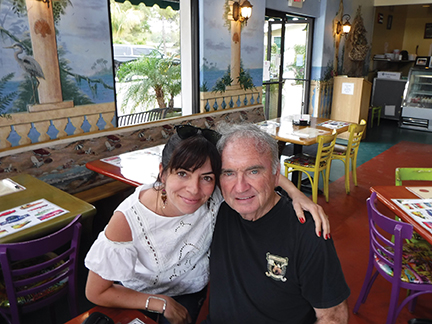 Goodbye Cuba
Goodbye Cuba
The Straits of Florida are a well-defined component of the Gulf Stream, 6,000 feet at its deepest point and reaching within a half mile of Havana. The course from Key West to Havana runs south and west against the flow of the stream and conversely the return passage is given a boost towards Key West so the trip back is usually faster than the trip down.
We left with fair winds and a clear sky. The lights of Havana were visible for miles as we looked back at the island. Our motor sailing speed at seven to eight knots, boosted by the stream, made for good progress. My shipmates and I continued through the evening with few difficulties. At the midway point, far beyond any light pollution, I watched the night sky glide by with a majestic constellation of stars.
Dawn arrived and after a few more hours of smooth sailing we docked at Stock Island Marina at 10:30 am, 15 hours after we set out from Havana. We beat the cold front by a day as it roared into Key West accompanied by high winds and small craft warnings. This front kept its grip on us for another week, day after day the forecast was for more of the same. At any rate, we were back in the States with one final task to complete; we checked in at the U.S. Customs office at the Key West Airport and delivered our garbage for incineration.
Later, Alex, an experienced videographer, produced a short YouTube clip about the trip with the ending caption, “So, Captain Jimmy, where are we going next?”
I had no idea. I was going back to Atlanta to do absolutely nothing but play a little golf.

















